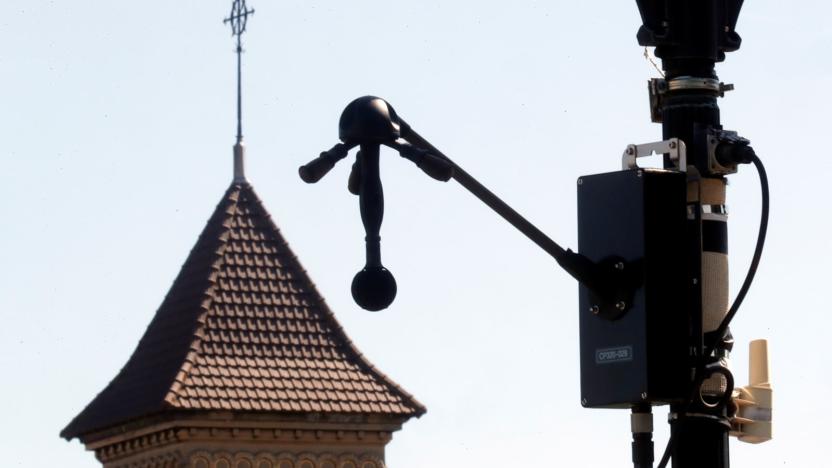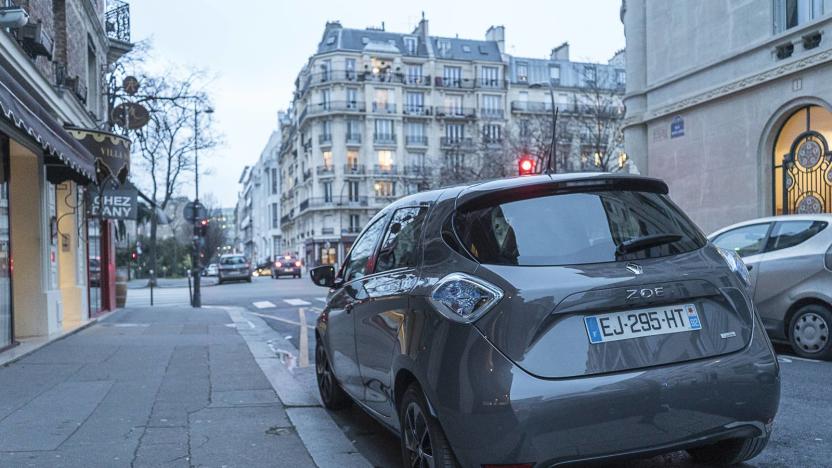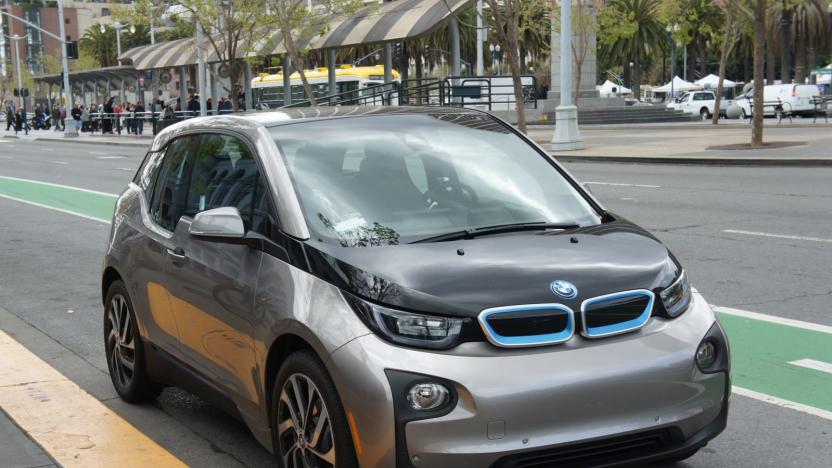noise
Latest

Paris is testing 'noise radar' that will automatically ticket loud cars
Parisians with powerful cars might want to think carefully before showing off their rides. Parts of the city (most recently the suburb of Villeneuve-le-Roi) are testing a "noise radar" system from Bruitparif that can pinpoint loud vehicles and, eventually, ticket them. The system uses four microphones to triangulate the origins of a sound and link it with CCTV footage to pinpoint whoever's making the racket.

New electric cars in Europe have to make artificial noises
Don't be surprised if you hear more of a racket from electric cars in Europe. As of July 1st, new four-wheeled EV models in the European Union require a noise-emitting device (Acoustic Vehicle Alert System, or AVAS) that kicks in whenever the vehicle is driving below 19km/h (12MPH). The system will theoretically prevent pedestrians and cyclists from being caught unawares by cars that would otherwise be near-silent. It's not a particularly irksome sound, as you can find out below, but it could stop you from crossing the street when there's a less-than-attentive driver.

Sony sneaks out a quieter PS4 Pro
Unless there are very significant changes involved, updates to gaming consoles are rarely released to any fanfare, silently slipping on to the market with minor tweaks designed to rectify any teething problems associated with that model's launch. That the latest release of the PS4 Pro was so discreet is fitting, then, because its revision has made it the quietest PS4 Pro yet.

European EVs must be fitted with sound emitters by 2021
Electric vehicles come with a raft of features that make them a great benefit in our noisy, polluted world, but now one previously-lauded quality is under fire. Campaigners say that EVs' lack of noise -- particularly when traveling at low speeds -- poses a significant safety risk to cyclists and pedestrians. The EU agrees, and so from July 2019 all new electric and hybrid vehicles sold in Europe must emit a noise when travelling slowly. Existing EVs will have to be retrofitted with a device by 2021.

Pharrell Williams will co-own Roli's modular instrument business
There's no question that Pharrell Williams has had at least some fondness for technology (his Daft Punk collabs and gold-tinged smartphones were big clues), but now he's taking that appreciation to Will.I.Am levels. Roli has revealed that Pharrell is not only becoming its Chief Creative Officer, but will invest in and take co-ownership of the modular instrument startup. He'll have a vested interest in Roli's success, in other words. The company hasn't outlined the terms of the deal, but the superstar will help develop "revolutionary" digital instruments that are accessible and "iconic."

Some Pixel 2 phones are making strange noises
The Pixel 2 and Pixel 2 XL are Google's best-rated smartphones yet, but early quality-control and testing problems could ruin the sales party. On top of display color and burn-in issues that have prompted some to advise against buying the device for now, users are also reporting sound problems. According to around 100 buyers on Google's Pixel product forum, the Pixel 2, and to a lesser extent, Pixel 2 XL are emitting clicking and/or high frequency sounds from the call speaker.

Drone noise is driving people crazy
Do drones' characteristic lawnmower-on-helium sounds drive you batty? You're not alone. NASA researchers have conducted a study indicating that people find drone noise more annoying than that of any ground vehicle, even when you put the two at similar volumes. It was roughly equivalent to a car being twice as close as before, according to the researchers. And while there were just 38 people in the test, none of them were told what they were hearing or what the study was accomplishing. The results seem obvious if you've ever heard a drone, but there's a big question: why are they so irritating when cars create plenty of aural annoyance on their own?

FCC wants your help understanding radio noise
Interference from radio noise remains a big problem... and it's tricky enough that the FCC wants your help understanding the issue in the first place. The agency has put out a call for public input that should not only determine the scale of radio noise problems, but design the studies needed to measure them. It wants to identify the main sources of this noise, where it's most likely to happen and whether it varies based on time. It's particularly concerned about "incidental" noise from devices that aren't meant to emit radio frequencies, like motors or power lines.

US Army's smart earplugs spare soldiers from loud noises
As you might imagine, soldiers can't just use garden variety earplugs to protect their ears. It might tone down the sounds of explosions and gunshots, but it'll also prevent them from hearing a crucial command or an enemy on the other side of a doorway. It's less of an issue for the US Army these days, though. The military branch has been gradually rolling out a smart earplug, TCAPS (Tactical Communication and Protective System), that adapts to the audio realities of war. The smartphone-linked device softens louder noises, but amplifies quieter ones; if your squad leader needs to issue a command, you'll hear it over the din of battle.

Roli's quirky musical keyboard is now an iPhone app
When ROLI introduced the Seaboard -- a quirky interpretation of the musical keyboard -- it was hard not be curious. But, at $2,000, that's likely where you remained. Even the smaller, more affordable Seaboard Rise was a little out of reach for many casual musicians wanting to try its tactile trickery (watch this to see what we mean). Today, however, there's a ROLI for everyone, as the British firm has just announced Noise: a virtual Seaboard in iPhone app form. If you want to know why Apple's 3D Touch matters, it's apps like this that will show you -- and Noise is much easier on your pocket (in fact, it's free).

EU to require that EVs and hybrids make noise to alert pedestrians
The EU has been talking for years about requiring pedestrian alert noises on electric cars and hybrids, and some vehicles already do. In the future, however, those warning systems will be mandatory. The European Parliament has backed a proposal that would require sound-making hardware in new electric vehicles by July 2019. The European Commission would lock down the final rules by July 2017. Whether or not you're a fan of the potential regulation, gas-powered vehicles aren't being let off the hook. Parliament also wants to start lowering conventional engine noise levels as soon as July 2016, so every Europe-friendly automaker will have to be mindful of audio before too long. [Image credit: Harry_NL, Flickr]

This is what the Xbox 360 Achievement sound looks like
Whenever you hear that "boop-boop" drop-chime of Achievement on the Xbox 360, picture this floating, green jellyfish-like image, because that's what it looks like. This is according to design company Born of Sound, which makes noises into "sound-forms," or physical art.

Daily iPhone App: SoundMeter+ monitors your environment for hearing damaging noise
Most people don't think about their background noise levels, but those who work or live in noisy environments need to be aware of sounds that could ruin their hearing. If you have an iPhone or iPad, you can monitor your ambient noise levels using the new SoundMeter+ application. SoundMeter+ uses the iPhone's internal microphone to measure the surrounding noise and calculate the dBA of your surroundings. You can also change the meter to measure dBC, dBB, dBD and dBZ. These different measurements take into account the different frequencies of sound. For example, the A-weighting (dBA) emphasizes those frequencies that the human ear can hear, while the B-weighting (dBB) takes into account lower frequencies and is used to measure entertainment noise. The app shows a variety of information about your ambient sound levels. It displays a digital meter that gives you the exact dBA measurements and a graphical meter that shows how the noise fluctuates. It also keeps track of the max and min noise levels recorded by the app and the hold time for each one (i.e., how long each one lasted). SoundMeter+ not only measures the live sound levels, it also analyzes your ambient noise over time. This information is then used to calculate the Time Weighted Average (TWA), which measures the different noise levels that a person is subjected to throughout a normal working day. This figure is most commonly used by OSHA to assess a worker's exposure to hearing-damaging sounds. There's a lot of information packed into a very affordable US$1.99 app. My only quibble with the app is that it is not optimized for the iPhone 5. As a result, the meter only occupies two-thirds of the screen and the help file has too many blank spaces. Disclaimer: I did not test the SoundMeter+ app against a noise dosimeter or any other professional sound-measuring equipment. I only compared SoundMeter+'s measured sound levels to known levels, and the app was accurate with its measurements. Also, the app only calculates the background noise so you can become more aware of situations that require some form of hearing protection. It is not meant to be used in the diagnosis or treatment of any medical conditions. It's also not meant to be used as legal evidence in workplace safety disputes.

Audience noise-cancelling said not to feature in next iPhone
There was a time when Audience's contribution to the iPhone's call clarity was not only praised, but actively hunted down. But now it looks like the party is over -- at least according to the chip maker itself. Citing events "in the normal course of business" the firm believes that its technology won't be making it into Apple's next handset -- unsurprisingly a big blow for its shareholders. While it remains unconfirmed, Audience suggested in a conference call that Apple has built its own audio team. Something that is possible already creating a hubbub with other industry players. Though all things going well, we'll only have to wait a week until the new iPhone hits the surgeon's bench anyway.

Netatmo Urban Weather Station tells iOS users when it's safe to brave the great outdoors (video)
We haven't seen weather stations garner the same level of clever mobile integration as other pieces of household gear -- like, say, thermostats. Netatmo wants its newly available Urban Weather Station to inject a similar dose of life into a category that some of us still associate with the thermometer by the window. The aluminum tube design certainly gives a fresh look to the WiFi-linked indoor and outdoor sensors, but the real trick is the matching iOS (and eventually Android) app. It's for more than just gauging the wisdom of biking to work: the free app tracks historical trends and shares them with fellow users in a network that Netatmo hopes will provide a better understanding of wider-scale and longer-term trends. The sensors go beyond just obvious air quality, humidity, pressure and temperature conditions as well, flagging noise levels and warning if the CO2 levels are high enough to warrant airing out the house. The $179 price for the Urban Weather Station isn't trivial, but neither is knowing just how well you can cope with your environment.

Leica Monochrom test turns up the ISO, doesn't bring the noise
In the case of "why would you pay $8k for a black and white camera," exhibit 'A' would surely be the lack of a color filter array corrupting the image. Without one, the Leica Monochrom -- with a similar CCD to its M9 stablemate -- should have less noise. Tests comparing the two cameras on Red Dot Forum confirm it, with the Monochrom cleaner in glorious black & white at all ISO's up to the M9's maximum of 2500. Past that, a touch of NR gave the Monochrom a pleasing film-grain look to our eyes at ISO 5000, but at ISO 10,000 images started to sparkle and approach the "barely usable" range. Still, combined with the increased sharpness and resolution, very well-heeled purists might be tempted.

Jawbone Big Jambox review
It was back in February when we first caught wind a beefier version of Jawbone's Jambox, thanks to some less-than-stealthy ninjas at the FCC. Today it's officially here. Dubbed Big Jambox, this $300 Bluetooth speakerphone and "smartspeaker" is unsurprisingly a supersized -- yet still portable -- version of the new-age micro-boombox that the won us over back in 2010. Naturally, there have been some tweaks to go along with the bigger footprint, but all the core features including Jawbone's MyTalk apps and noise-cancelling know-how are in tow. Now that we've used it extensively for a few days, we're ready to answer some questions you might have. Does it follow the old adage that bigger is better? How will it fit into your lifestyle compared to the Jambox? And most importantly, is it worth the asking price?

Jawbone unleashes Big Jambox, beefs up its Bluetooth 'smartspeaker' lineup
We've had a shimmer in our eye for Jawbone's $200 Jambox, the itty bitty Bluetooth 'smartspeaker,' ever since it was released back in late 2010. So, imagine our delight now that the company has just stepped things up to a larger level with its new $300 Big Jambox. Measuring in at well over double the size of the original, the 2.7-pound speaker is still very similar in design and features the familiar perforated metal grill designs by Yves Behar -- starting May 15th, you can pick one up in your choice of Red Dot, Graphite Hex and White Wave. The larger footprint helps it to be more functionally capable than its sibling, yet it's still small enough to carry in one hand. On top, the unit sports playback controls in addition to the requisite volume and talk buttons, while on the side you'll find a USB connection (for software updates), power input 3.5mm jack, Bluetooth-pairing button and a power button. To pump out the jams, the Big Jambox features an airtight enclosure loaded with a duo of active neodymium drivers and opposing dual-passive bass radiators to handle all the wub wub you can throw at it. A 2,600mAh rechargeable battery will get you roughly 15 hours of totally wireless listening time (500 on standby), but -- as is the case with the original -- you still can't share that juice with your gadgets. Positively, Android users can take advantage of the Big Jambox's exclusive Companion app, which allows the unit to do tricks such like sync up with your G-cal to inform you about your appointments. Lastly, like the Jambox, the Big Jambox features MyTalk voice prompts / app compatibility, along with Live Audio DSP to give your sounds an immersive "3D" feel. Curious to find out more? We spent a full weekend with the new gizmo, and you can catch our full review by clicking here. Full press release after the break.

Audience earSmart eS110 brings its voice processing and noise suppression to low cost feature phones
Remember Audience? Sure you do. The outfit was behind the iPhone 4's noise-canceling wizardry that would be later built directly into the 4S' A5 heart. Now, the company has announced its earSmart eS110 advanced voice processor for feature phones. Touting "the same voice quality" as those more expensive phones that we all covet, the single microphone tech will suppress unwanted noise like cars passing by or that loud guy next to you at a bar. The eS110 offers crisp calls for both handset and speakerphone uses thanks to processors designed around how humans filter the sounds that we hear. Entry-level smartphones are targets as well and the kit's 3.5 x 3.5mm stature should make for easy integration. Audience says that samples will be sent out to manufacturers in March and should show up in handsets by the end of the year. In search of a few more details? Hit the full PR below to find out more.

Canon EOS-1D X and Nikon D4 ISO 204,800 shooting hands-on (video)
With mirrorless cameras offering high-resolution APS-C sensors and consecutive shooting speeds of up to 10 frames-per-second, what's left to make a $6,000 full-frame DSLR a compelling purchase, especially for amateur photographers? Low-light performance, for one -- the Canon EOS-1D X and Nikon D4 are both capable of capturing images at up to ISO 204,800, letting you snap sharp photos in even the dimmest of lighting conditions. The benefits of a top sensitivity of ISO 204,800 are significant -- jumping from one ISO to the next doubles your shutter speed. So an exposure of f/2.8 at 1/2 second at ISO 400 becomes 1/4th at ISO 800, 1/15th at ISO 3200, 1/60th at ISO 12,800, 1/250th at ISO 51,200 and a whopping 1/1000th at ISO 204,800 -- fast enough to freeze a speeding car.Both Canon and Nikon have yet to allow us to take away samples shot with the 1D X or D4 -- the companies even taped CF card slots shut to prevent show attendees from slipping their own card in -- but we were still able to get a fairly good idea of high-ISO performance from reviewing images on the built-in LCDs. At the cameras' top sensitivity of ISO 204,800, noise was visible even during a full image preview. Zooming into the image revealed significant noise, as expected. However, within each camera's native range of ISO 100 to 25,600, noise was barely an issue at all. Both cameras are still pre-production samples at this point, so we'll need to wait for production models to make their way out before we can capture our own samples, but based on what we saw when reviewing ISO 204,800 images on the built-in LCDs, that incredible top-ISO setting may actually be usable. Scroll on through the gallery below to preview some top sensitivity shots on the Canon EOS-1D X (camera poster) and the Nikon D4 (Japanese model), and join us past the break for an even closer look in our video hands-on.








